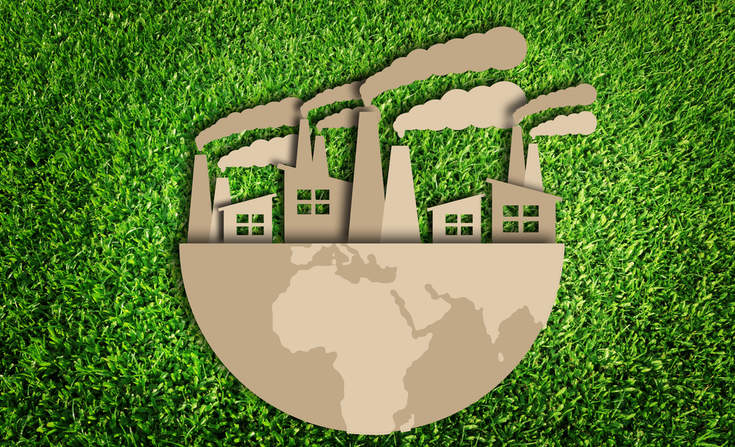 |
| Reviews and Templates for Expression We |
State of Green Business: Carbon recycling's growing promise
The following is an excerpt from the GreenBiz State of Green Business 2016 report.
Global efforts to address climate change have focused to date on reducing emissions of greenhouse gases through such measures as using energy more efficiently, switching to renewable power and electrifying vehicles.
But what if the carbon in waste gases from power plants, cement plants, waste digesters or steel works could be captured and used to make things, thereby turning pollutants into products?
A small but growing band of companies is trying to do just this through a group of technologies one could call "carbon recycling." They use the carbon in greenhouse gases, such as carbon dioxide (CO2) or methane, as a raw material to make products such as plastic or cement.
A common misconception about carbon recycling is that CO2 from the atmosphere can be used, directly reducing greenhouse gas concentrations. That’s not the case. The atmosphere is mostly nitrogen and oxygen; CO2 makes up well under 1 percent, so extracting it from the atmosphere is costly and inefficient. Industrial emissions, however, provide a concentrated source of carbon that can be economically extracted while keeping it out of the atmosphere.
Turning CO2 waste into materials is nascent technology, to be sure. Understanding the feasibility of this concept requires answering three questions before the technology seriously can be considered as a solution to climate change:
- Wouldn’t it be better to invest in technologies that don’t release carbon in the first place, such as renewable energy?
- Can carbon recycling advance beyond the R&D stage to become fully commercial businesses that put a dent in the 36 billion metric tons of carbon dioxide released globally each year from burning fossil fuels?
- Do carbon-recycling technologies have genuine net environmental benefits that can be quantified and communicated?
In answer to the first question: The world needs every solution it can get, given the enormity of the climate challenge. Renewables are vital, of course, but many new energy-hungry economies are continuing to invest in new fossil-fuel power plants that could operate for 30 years or more.
Given that stopping greenhouse emissions altogether won't happen anytime soon, we need solutions to prevent these emissions from entering the atmosphere.
One of the most promising carbon recycling companies is Newlight Technologies. Founded in 2003, the California company developed, patented and commercialized the world’s first carbon sequestration technology able to produce high-performance plastic that can match the performance and price of petroleum-based plastic.
Newlight’s plastic product, which it calls AirCarbon, is made from methane, a carbon-rich waste gas from farms, landfills and water treatment plants. By taking methane from industrial and agricultural facilities and locking it up in plastic, rather than releasing it into the atmosphere, Newlight stands to make a contribution towards reducing global warming.
Several companies have started using AirCarbon, such as Sprint for cell phone cases and Dell for packaging computers. Last year, cosmetics company the BodyShop, a unit of L’Oreal, announced a research and development partnership with Newlight to use AirCarbon to make containers and caps.
As far as carbon recycling’s commercial prospects, Newlight last summer signed a deal with chemicals company Vinmar to supply more than 19 billion pounds of AirCarbon plastic over 20 years, securing the future for Newlight’s planned 50 million pound per year production facility. That qualifies as going well beyond mere R&D.
Plastic isn’t the only application of carbon-recycling technology. New Jersey-based Solidia Technologies has developed a type of cement that is produced at lower temperatures, and through a different chemical reaction that generates less CO2 than conventional cement. The cement is hardened by injecting it with CO2 from industrial sources.
Since 2013, global cement giant Lafarge has collaborated with Solidia to commercialize the technology, including conducting full-scale trials at two Lafarge sites in the U.S. and Europe. The cement was used to produce pre-cast concrete products, such as paving blocks and roof tiles.
In answer to the third question about the feasible environmental benefits of carbon recycling, Solidia stated that the carbon footprint of its concrete is 70 percent smaller than that of conventional concrete. Tom Schuler, Solidia’s president and CEO, said that the cement industry’s commitment to cut CO2 emissions 20 to 25 percent by 2030 could be achieved now if cement companies switched to Solidia’s cement.
Several other companies are developing interesting carbon-recycling technologies related to other types of materials. Novomer has developed a way to transform waste CO2 into high-performance, low-cost chemicals called polyols for use in applications such as coatings, adhesives, sealants, elastomers and foams. These contain up to 50 percent CO2 by mass. Overall, the carbon footprint of Novomer’s polyols is at least a third less than comparable petrochemical products, the company stated.
Even better, the products outperform their conventional counterparts. Novomer, based in Massachusetts, stated that in addition to waste CO2 being a very low-cost raw material, it also gives products greater strength and durability. For example, German industrial adhesives company Jowat uses Novomer’s polyols in its polyurethane hot-melt adhesive applications.
There’s more. Liquid Light, based in New Jersey, uses low-energy catalytic electrochemistry to convert CO2 into chemicals, such as ethylene glycol, a raw material for plastic bottles. Austin-based Skyonic Corporation turns CO2 emissions from power plants and industrial processes into products to manufacture baking soda.
As an additional incentive, the $20 million NRG COSIA Carbon XPRIZE, launched last year, will be awarded to companies that can demonstrate new technologies to take carbon from power-plant emissions and turn it into products and materials. That should prime the pump for further innovations.
|
|
|
|
Copyright remains with the original authors |
